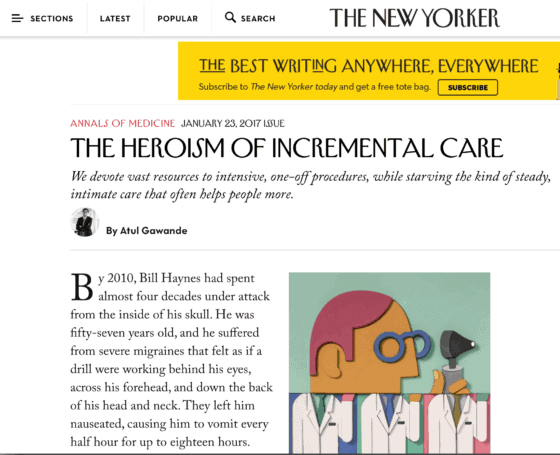This post in <50 words: Are there parallels between medicine and organizations when we look at the tension between heroism and the sometimes boring work of preventing problems and improving things? I comment on an article by Dr. Atul Gawande…
I recently saw Dr. Atul Gawande (see my previous posts about him) on TV, talking about our healthcare system and his most recent article for The New Yorker about “The Heroism of Incremental Care.”

The subheadline makes me think about Lean and process improvement:
“We devote vast resources to intensive, one-off procedures, while starving the kind of steady, intimate care that often helps people more.”
Many organizations devote “vast resources” to big interventions — major projects, new technologies, new facilities, or multi-year consulting contracts. At the same time, they often starve the “steady intimate” improvement “that often helps people more.”
I think of Kaizen and continuous improvement, engaging everybody in what's usually incremental improvement.
As I wrote about yesterday, there's a time and a place for redesign and reinvention… and a time for systematic incrementalism.
there's a time and a place for redesign and reinvention... and a time for systematic incrementalism. Share on XRather listen than read? Hear Mark read this post (subscribe to the podcast):
Gawande Sets the Stage
He writes about a patient with really severe migraines. He and his wife found different solutions (some more legitimate, like nightguards, then others, like herbal treatments). Gawande explains:
“…occasionally a remedy would help for a brief period, but nothing made a lasting difference.”
This reminds me of the “program of the month” mentality in many organizations… helps for a brief period, but not making a lasting difference. Sadly, Lean sometimes gets treated as this program or fad.
A doctor at the The John Graham Headache Center tells Gawande about how they diagnose a patient:
“You ask them to tell the story of their headache and then you stay very quiet for a long time.”
This makes me think of the difference between a consultant who is ready to push ready-made solutions and those who spend more time listening and understanding the current state and the problem at hand. That's good Lean problem solving to do the latter.
The doctor lets the patient tell that story:
“She did not interrupt or comment, except to say, “Tell me more,” until the full story emerged.”
I've found that “tell me more” and “why is that?” are great questions to ask podcast guests and they also help in my consulting.
After the patient's description of symptoms was complete:
“[Dr.] Loder gave a sympathetic shake of her head, and that was enough to win the woman's confidence. The patient knew that she'd been heard by someone who understood the seriousness of her problem…”
Was Gawande going to see any miracle cure here in this clinic? Here's what happened next:
“She started, disappointingly, by lowering expectations. For some ninety-five percent of patients who see her, including this woman, the diagnosis is chronic migraines. And for chronic migraines, she explained, a complete cure was unlikely. Success meant that the headaches became less frequent and less intense, and that the patients grew more confident in handling them. Even that progress would take time. There is rarely a single, immediate remedy, she said, whether it was a drug or a change in diet or an exercise regimen. Nonetheless, she wanted her patients to trust her. Things would take a while–months, sometimes longer. Success would be incremental.”
Does that remind you of an organization's Lean transformation journey? Many executives expect what Dr. Deming would have called “instant pudding.” Lean is a not quick-fix overnight success story. It takes time and effort. It takes redesign and incremental improvement…
The doctor puts together a plan that sounds like a PDSA approach (or a Toyota Kata method – read this great article about applying this to patient care):
“…together they would make small changes in treatments and review the diary every few months.”
This also the Kaizen process… understand the situation, make small changes, measure, and adjust.
When working with another patient:
“When one medicine caused side effects he couldn't tolerate, [the physician] switched to another, but that one didn't produce any reduction in headaches. He saw her every three months, and they kept on measuring and adjusting.”
After things got better (not cured, but attacks were less frequent):
“I haven't had a dreadful attack since March 13, 2014,” he said, triumphantly. It had taken four years of effort. But Loder's systematic incrementalism had done what nothing else had.”
Later in the piece, Gawande writes something that makes me think, again about episodic improvement and incremental improvement:
“Success, therefore, is not about the episodic, momentary victories, though they do play a role. It is about the longer view of incremental steps that produce sustained progress.”
Rapid Improvement Events and projects — big interventions — are often exciting and sexy. But, the results and progress are often not sustained. Sometimes, implementing lots of little incremental improvements makes a big impact AND is more sustainable, for a number of reasons.
Gawande on Healthcare and Fire Fighting
Years ago, I heard Gawande talk before about how the past generation had made many huge medical discoveries, such as vaccines and organ transplants. These were huge step function improvements, huge leaps, like going from the horse and buggy to a Tesla electric car overnight. He comes back to this same theme in the article and concludes:
Gawande: We built our health-care system, accordingly, to deploy firefighters. Doctors became saviors. Share on X“We built our health-care system, accordingly, to deploy firefighters. Doctors became saviors.”
As I read this, I think about how there's a difference between developing new technologies to put fires out (which can help) and developing new approaches to preventing fires from occurring. The compensation system for firefighters doesn't reward them for putting more fires out.
A friend of mine from high school is a professional firefighter and EMT in Nevada. We've talked about he spends more time working, in different ways, to prevent fires – through education, inspections, and such.
What we describe as reactive “fire fighting” in organizations is somewhat unfair to the real pros, like my friend.
Gawande adds:
“But the model wasn't quite right. If an illness is a fire, many of them require months or years to extinguish, or can be reduced only to a low-level smolder. The treatments may have side effects and complications that require yet more attention. Chronic illness has become commonplace, and we have been poorly prepared to deal with it. Much of what ails us requires a more patient kind of skill.”
And he also writes:
“I was drawn to medicine by the aura of heroism–by the chance to charge in and solve a dangerous problem.”
How many people, in business or healthcare organizations, were drawn to management by that same heroism? How many were promoted up through the ranks to the C-suite because they were great at reacting, taking charge, and fighting fires?
Too many organizations don't reward and they don't promote the people who prevent workplace “fires” because that doesn't draw as much attention.
The need to change this, through Lean management styles, is the reason that the great book by Kim Barnas is titled Beyond Heroes. You can listen to my podcast with her about the book.
I wrote a post about this in 2008: “Process Firefighting, Sometimes the Result of Process Arsonists?“
As a patient, when I think of healthcare, I think of an analogy to fire prevention. I want a healthcare system that helps me stay healthy (that's how I define “value”) instead of just reacting better to things that might go wrong with my health.
Gawande describes his medical training and the need to react and save a patient's life by reacting quickly, slashing open their belly, and removing a bleeding spleen.
“How can anyone not love that? I knew there was a place for prevention and maintenance and incremental progress against difficult problems. But this seemed like the real work of saving lives. Surgery was a definitive intervention at a critical moment in a person's life, with a clear, calculable, frequently transformative outcome.”
In the management and improvement of organizations, yes, there is a time and a place to react. Sometimes quick action is needed.
But, when it's not an immediate matter of life and death, W. Edwards Deming would often remind people that it's sometime better to not overreact and “tamper” with a system.

Of course, if a patient is bleeding or a building is literally on fire, you don't just stand there.
But think of situations, like I discussed in my recent webinar, where a manager overreacts to every up and down in daily performance of a department… this overreaction (explain what went wrong yesterday!) can cause more problems than standing there and studying the system… and thinking about ways to either redesign that system or ways to incrementally improve it. That's what leads to better performance. And it's not all reactive.
This post has gotten long. I've been writing it as I've been reading Gawande's article. I'll read the rest (and encourage you to do so) and I might write more.
What are your thoughts on any of this? Please leave a comment below.
Reminder: You can enter to win sets of #Lean books, including Lean Hospitals, through this contest sponsored by StoreSMART… through January 31. Learn more.
What do you think? Please scroll down (or click) to post a comment. Or please share the post with your thoughts on LinkedIn – and follow me or connect with me there.
Did you like this post? Make sure you don't miss a post or podcast — Subscribe to get notified about posts via email daily or weekly.
Check out my latest book, The Mistakes That Make Us: Cultivating a Culture of Learning and Innovation:










Mark,you have beautifully integrated Gawande’s article and principles of Lean for healthcare organisations.This is because of your passion and deep understanding of the subject.I am a new student of Lean,a doctor running small hospital in India, and enjoyed reading your blog.